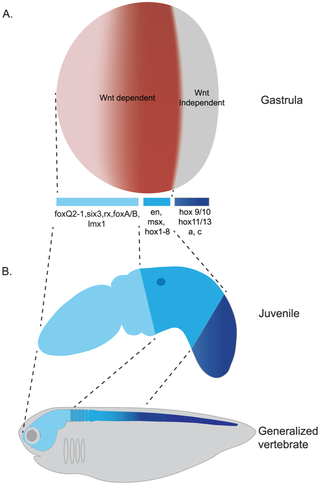PLOS Biology ( IF 7.8 ) Pub Date : 2018-01-16 , DOI: 10.1371/journal.pbio.2003698 Sébastien Darras 1 , Jens H Fritzenwanker 2 , Kevin R Uhlinger 2 , Ellyn Farrelly 3 , Ariel M Pani 3 , Imogen A Hurley 3 , Rachael P Norris 4 , Michelle Osovitz 5 , Mark Terasaki 4 , Mike Wu 6 , Jochanan Aronowicz 3 , Marc Kirschner 7 , John C Gerhart 6 , Christopher J Lowe 2

|
The Wnt family of secreted proteins has been proposed to play a conserved role in early specification of the bilaterian anteroposterior (A/P) axis. This hypothesis is based predominantly on data from vertebrate embryogenesis as well as planarian regeneration and homeostasis, indicating that canonical Wnt (cWnt) signaling endows cells with positional information along the A/P axis. Outside of these phyla, there is strong support for a conserved role of cWnt signaling in the repression of anterior fates, but little comparative support for a conserved role in promotion of posterior fates. We further test the hypothesis by investigating the role of cWnt signaling during early patterning along the A/P axis of the hemichordate Saccoglossus kowalevskii. We have cloned and investigated the expression of the complete Wnt ligand and Frizzled receptor complement of S. kowalevskii during early development along with many secreted Wnt modifiers. Eleven of the 13 Wnt ligands are ectodermally expressed in overlapping domains, predominantly in the posterior, and Wnt antagonists are localized predominantly to the anterior ectoderm in a pattern reminiscent of their distribution in vertebrate embryos. Overexpression and knockdown experiments, in combination with embryological manipulations, establish the importance of cWnt signaling for repression of anterior fates and activation of mid-axial ectodermal fates during the early development of S. kowalevskii. However, surprisingly, terminal posterior fates, defined by posterior Hox genes, are unresponsive to manipulation of cWnt levels during the early establishment of the A/P axis at late blastula and early gastrula. We establish experimental support for a conserved role of Wnt signaling in the early specification of the A/P axis during deuterostome body plan diversification, and further build support for an ancestral role of this pathway in early evolution of the bilaterian A/P axis. We find strong support for a role of cWnt in suppression of anterior fates and promotion of mid-axial fates, but we find no evidence that cWnt signaling plays a role in the early specification of the most posterior axial fates in S. kowalevskii. This posterior autonomy may be a conserved feature of early deuterostome axis specification.
中文翻译:

半索动物发育过程中早期典型 Wnt 信号传导的前后轴模式
分泌蛋白的 Wnt 家族被认为在两侧对称动物前后 (A/P) 轴的早期规范中发挥保守作用。这一假设主要基于脊椎动物胚胎发生以及涡虫再生和稳态的数据,表明规范的 Wnt (cWnt) 信号赋予细胞沿 A/P 轴的位置信息。在这些门之外,人们强烈支持 cWnt 信号在抑制前命运中的保守作用,但相对支持在促进后命运中的保守作用却很少。我们通过研究 cWnt 信号在沿半索动物Saccoglossus kowalevskii的 A/P 轴早期模式形成过程中的作用,进一步检验了这一假设。我们克隆并研究了S的完整 Wnt 配体和卷曲受体补体的表达。 kowalevskii在早期发育过程中与许多分泌的 Wnt 修饰因子一起。 13 种 Wnt 配体中的 11 种在外胚层的重叠结构域中表达,主要在后部,而 Wnt 拮抗剂主要定位于前部外胚层,其模式让人想起它们在脊椎动物胚胎中的分布。过表达和敲低实验与胚胎学操作相结合,确定了 cWnt 信号对于S早期发育过程中前命运的抑制和中轴外胚层命运的激活的重要性。科瓦列夫斯基。然而,令人惊讶的是,由后Hox基因定义的最终后命运对囊胚晚期和原肠胚早期 A/P 轴早期建立过程中 cWnt 水平的操纵没有反应。 我们为后口动物身体计划多样化过程中 A/P 轴的早期规范中 Wnt 信号传导的保守作用建立了实验支持,并进一步为该通路在两侧对称动物 A/P 轴的早期进化中的祖先作用建立了支持。我们发现强有力的支持 cWnt 在抑制前轴命运和促进中轴命运中的作用,但我们没有发现任何证据表明 cWnt 信号在S中最后轴命运的早期规范中发挥作用。科瓦列夫斯基。这种后部自主性可能是早期后口轴规范的保守特征。











































 京公网安备 11010802027423号
京公网安备 11010802027423号